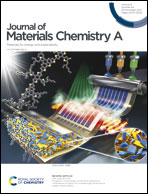Janus behaviour of LiFSI- and LiPF6-based electrolytes for Li metal batteries: chemical corrosion versus galvanic corrosion†
Abstract
Li metal has been considered a promising anode for high energy density Li batteries because of the lowest redox potential and high specific capacity of the Li/Li+ redox couple. However, Li metal technology is currently impractical because of its poor calendar aging behaviour due to chemical and galvanic corrosion, although recent efforts have shown promise in improving the cycle performance of Li metal. Calendar aging of Li metal is one of the challenges that must be overcome to translate research into practical applications. Nevertheless, even the calendar aging mechanism of Li metal is not yet fully understood. Herein, the Janus behaviour of LiPF6- and LiFSI-based electrolytes in the electrochemical performance of Li metal is demonstrated in terms of chemical corrosion and galvanic corrosion. LiFSI is superior to LiPF6 in chemical corrosion, whereas LiFSI is inferior to LiPF6 in galvanic corrosion. This is attributed to the fact that LiPF6- and LiFSI-based electrolytes show remarkably different behaviour of electrolyte decomposition on the Li metal and Cu substrate surfaces. Moreover, the ensemble effect of LiFSI salt and VC additive is introduced to simultaneously suppress galvanic corrosion and chemical corrosion, leading to not only excellent cycle performance but also improved calendar aging.



 Please wait while we load your content...
Please wait while we load your content...